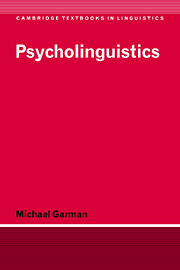Book contents
- Frontmatter
- Contents
- List of illustrations
- List of tables
- Preface
- Acknowledgements
- List of abbreviations
- PART 1 Elements of psycholinguistics
- 1 Characteristics of the language signal
- 2 The biological foundations of language
- 3 Sources of evidence for the language system
- PART 2 Processes and models
- References
- Index of names
- Subject index
3 - Sources of evidence for the language system
from PART 1 - Elements of psycholinguistics
Published online by Cambridge University Press: 05 June 2012
- Frontmatter
- Contents
- List of illustrations
- List of tables
- Preface
- Acknowledgements
- List of abbreviations
- PART 1 Elements of psycholinguistics
- 1 Characteristics of the language signal
- 2 The biological foundations of language
- 3 Sources of evidence for the language system
- PART 2 Processes and models
- References
- Index of names
- Subject index
Summary
Introduction
Preview
In this chapter, we consider the third of our designated elements of psycholinguistics: the nature of the language system. Information about the properties of this abstract system constitutes a further constraint – along with those arising out of our considerations in the previous two chapters – on the possible forms that language processing might take.
Our approach will review the available sources of evidence, and will concentrate initially on some general features of naturalistic language data, in contrast to experimentally elicited data. We shall introduce a sample of adult conversational speech (section 3.1.3); then we shall consider two specific types of property in this data, hesitation phenomena (non-fluencies) (section 3.2) and grammatical characteristics, including lexical, phrasal and clausal elements and patterns (section 3.3). It should be noted that, regrettably, we shall not have anything to say on hesitation phenomena in the production of written language, nor on the distinctive grammatical features of written language: these topics are too large to be adequately treated here. See Griffiths (1986) for a temporal measure of constituent structure organisation in copying of written language; and Perera (1984) for developmental aspects.
Finally, we shall examine the evidence that has been gleaned from various studies of spontaneously occurring errors, in speech production (slips of the tongue), auditory comprehension (slips of the ear), writing (slips of the pen) and reading (slips of the eye).
- Type
- Chapter
- Information
- Psycholinguistics , pp. 109 - 178Publisher: Cambridge University PressPrint publication year: 1990



